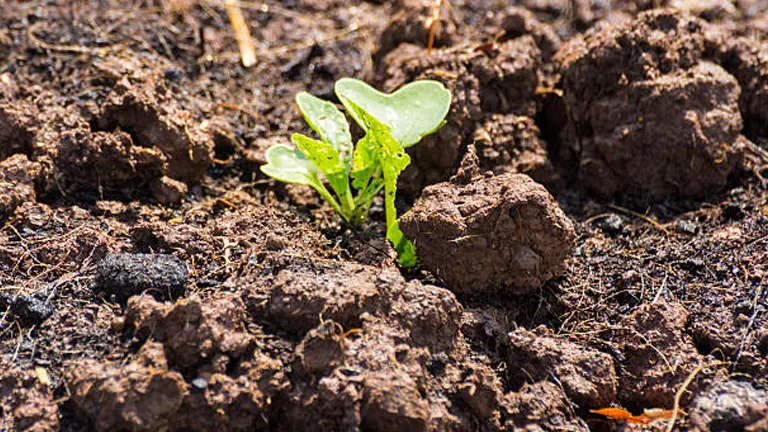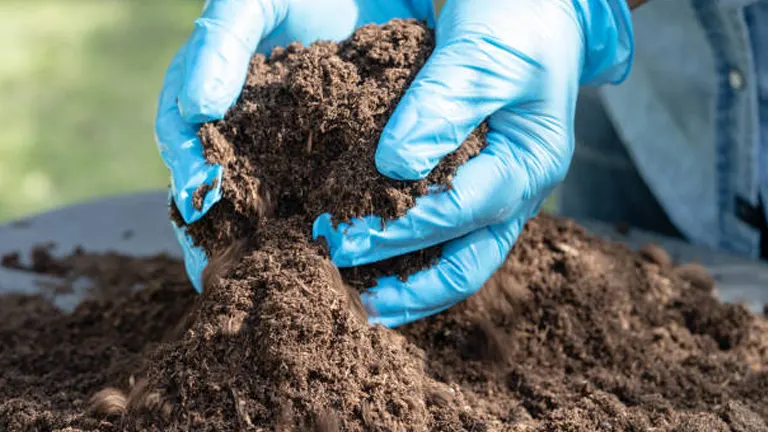How to Improve Garden Soil With Amendments: Unlock the Secrets to Lush Growth
- June 4, 2024
- 0 comment
Learn how to improve garden soil with amendments for unparalleled growth. Master the secrets to lush, vibrant gardens today. Want a healthier garden? It begins with your soil. Improving your garden soil with the right amendments can significantly boost plant health and growth.

This guide will show you the best amendments to use and how to apply them effectively. Learn to create a nutrient-rich environment that ensures your plants thrive. Let’s get started on the path to a more productive garden.
Table of Contents
- Understanding Your Soil
- Types of Soil Amendments
- How to Choose the Right Amendments for Your Soil
- Step-by-Step Guide to Applying Soil Amendments
- Long-Term Soil Health Management
- Common Mistakes to Avoid When Amending Soil
- Conclusion
- FAQs
Understanding Your Soil

Understanding the texture and structure of your soil is the first step in creating a healthy garden. Soil texture, defined by the size of the soil particles, directly affects its drainage and nutrient holding capacity. Here’s a more detailed look at common soil types:
- Clay Soils: Composed of fine particles that stick together, creating a dense structure that retains water but reduces porosity and air movement. While they hold nutrients well, their compaction can restrict root growth and require amendments that improve aeration, such as gypsum or coarse sand.
- Sandy Soils: Characterized by large particles with significant gaps between them, these soils drain quickly but do not hold nutrients efficiently. Organic matter such as compost or peat can enhance their ability to retain both water and nutrients.
- Loam: This is considered the ideal garden soil. It balances sand, silt, and clay, promoting water retention, nutrient availability, and excellent drainage. Enhancing loam involves maintaining its structure with regular additions of organic matter.
Advanced Soil Testing
A comprehensive soil test is more than just a pH test; it includes detailed analyses of nutrient content and soil composition. This testing reveals levels of:
- Macronutrients: Nitrogen (N), Phosphorus (P), and Potassium (K)
- Micronutrients: Iron (Fe), Manganese (Mn), Copper (Cu), Zinc (Zn), and Boron (B)
- Soil pH: Optimal pH levels vary by plant species, but most garden plants prefer a pH between 6.0 and 6.8. Deviations can lock out essential nutrients, making them unavailable to plants.
The results help pinpoint exactly what your soil lacks or has in excess. For example, a nitrogen deficiency can lead to stunted growth and pale leaves, while excess nitrogen can cause lush foliage growth at the expense of flowers and fruits.
Identifying and Addressing Common Soil Problems:
- Compaction: Common in high-traffic areas or heavy clay soils. It impedes root expansion, water infiltration, and air penetration. Aerating the soil and adding organic matter can relieve compaction.
- Nutrient Deficiency: Each nutrient deficiency shows specific symptoms, e.g., potassium deficiency often appears as leaf edge yellowing. Based on soil test results, targeted fertilization can correct these deficiencies.
- Poor Drainage: Excessive water retention can lead to root diseases and poor plant health. Amending with organic matter can improve the structure and drainage of clay soils, while raised beds or drainage systems might be necessary solutions.
Scientific Table: Soil Properties and Amendment Impacts
| Soil Property | Impact on Plants | Common Issues | Amendments Recommended |
|---|---|---|---|
| Clay Content | High water retention, low aeration | Compaction, poor drainage | Organic matter, sand, gypsum |
| Sand Content | Quick drainage, low nutrient retention | Nutrient leaching, dryness | Compost, peat moss |
| pH Level | Nutrient availability | Nutrient lockout | Lime or sulfur (to adjust pH) |
| Organic Matter | Improves structure, nutrient retention | Susceptibility to erosion | Compost, manure |
Types of Soil Amendments

Soil amendments are crucial for optimizing the health and structure of garden soil. They can be broadly categorized into organic and inorganic types, each serving distinct purposes and catering to specific soil needs. Here’s a detailed exploration of these amendments, including scientific insights and practical applications.
Organic Amendments
- Compost: Compost is a powerhouse of organic matter, rich in decomposed plant and animal residues. It dramatically enhances soil structure, moisture retention, and microbial activity. Scientific studies show that integrating compost can increase soil organic matter by up to 50%, improving water retention by up to 20% in sandy soils and enhancing porosity and aeration in clay soils. Use compost by incorporating a 3-5 inch layer into the top 6-8 inches of soil, ideally in the early spring or fall.
- Manure: Well-aged manure is a nutrient-dense amendment that adds significant amounts of nitrogen, phosphorus, and potassium to the soil—essential elements for plant growth. It also introduces beneficial microorganisms that aid in soil health. Ensure that the manure is fully composted to avoid the risk of nutrient burn and pathogen transmission to plants. Incorporate manure into the soil at least 2-3 months before planting to allow for nutrient stabilization.
- Peat Moss: While effective for moisture retention, peat moss should be used judiciously due to its environmental impact and acidic nature. It is particularly useful in alkaline soils to lower the pH and enhance the growing conditions for acid-loving plants. However, it can bind nitrogen when first added, so it’s advisable to pair it with a nitrogen-rich amendment. Mix peat moss into the soil at a depth of 12-18 inches to maximize its benefits without affecting nitrogen availability severely.
Inorganic Amendments
- Lime: Lime is crucial for correcting soil acidity, particularly in regions with naturally acidic soils. It provides calcium and magnesium, improving nutrient availability and promoting robust plant health. The application rate should be determined by a soil test, but generally, 50 to 100 pounds per 1,000 square feet can effectively raise the soil pH over a single season. Lime should be applied biennially to maintain optimal pH levels.
- Gypsum: Gypsum is an excellent soil conditioner, particularly for saline and sodic soils. It helps to displace sodium on clay particles and replace it with calcium, thereby improving soil structure and drainage without altering pH. Scientific data suggest gypsum can increase soil calcium levels by up to 25%, enhancing root growth and soil stability. Apply gypsum at a rate of 20-40 pounds per 1,000 square feet, depending on soil compaction levels.
- Perlite and Vermiculite: These expanded volcanic rocks serve distinct purposes; perlite enhances soil aeration and drainage—ideal for water-sensitive plants and high-clay soils. Vermiculite, on the other hand, excels in moisture retention and nutrient release, making it suited for moisture-loving plants and sandy soils. Both should be mixed thoroughly at a 10-20% volume ratio to the soil to achieve the best results.
Comparative Table of Soil Amendment Impacts
| Amendment | Primary Benefits | Typical Application Rate | Ideal Soil Type |
|---|---|---|---|
| Compost | Enhances structure, nutrient content | 3-5 inches mixed into top 6-8 inches | All types |
| Manure | Adds nutrients, improves structure | 2-4 inches mixed into top 6-8 inches before season | All types, use composted only |
| Peat Moss | Increases acidity, water retention | Mix 12-18 inches deep, sparing use | Alkaline soils |
| Lime | Raises pH, adds calcium and magnesium | 50-100 lbs per 1,000 sq ft biennially | Acidic soils |
| Gypsum | Improves soil structure, adds calcium | 20-40 lbs per 1,000 sq ft, depending on need | Saline, sodic soils |
| Perlite | Improves aeration and drainage | 10-20% of soil volume | High-clay soils |
| Vermiculite | Retains moisture and nutrients | 10-20% of soil volume | Sandy soils |
How to Choose the Right Amendments for Your Soil

Choosing the correct soil amendments is crucial for transforming garden soil into a fertile foundation for plants. This decision must be informed by thorough soil testing that provides detailed insights into soil pH, nutrient levels, and texture. Here, we delve deeper into how to select amendments tailored to your soil’s specific characteristics, supported by scientific data and practical guidelines.
Tailoring Amendments to Soil pH
Acidic Soils (pH below 6.0):
- Lime: Commonly used to neutralize acidic soils, lime (calcium carbonate) raises soil pH, making it more alkaline and conducive for most garden plants. Scientifically, lime can increase soil pH by 0.5 to 1.0 units. Apply 50 pounds per 1,000 square feet to raise pH gradually over a season.
- Wood Ash: Another option for mildly acidic soils, wood ash not only raises pH but also contributes potassium and trace elements. Use sparingly, as excessive amounts can lead to imbalances.
Alkaline Soils (pH above 7.0):
- Peat Moss: This amendment is effective for slightly reducing pH and is especially beneficial for acid-loving plants. Peat moss also increases the soil’s water-holding capacity, crucial for integrating into alkaline, often arid soils.
- Elemental Sulfur: When a significant pH reduction is needed, elemental sulfur is the amendment of choice. It gradually lowers pH and is best applied a year in advance of planting due to its slow-acting nature.
Tailoring Amendments to Soil Type
Sandy Soils:
- Compost: Rich in organic matter, compost improves moisture and nutrient retention in sandy soils. Integrating 3 to 4 inches into the soil can enhance its capacity to hold nutrients and water by up to 20%.
- Vermiculite: This mineral increases the soil’s ability to retain water and nutrients, acting like a sponge. It’s particularly effective in nutrient-poor sandy soils.
Clay Soils:
- Gypsum: Ideal for breaking up compacted clay soils, gypsum improves soil structure and drainage without affecting pH. Application of 40 pounds per 1,000 square feet can significantly enhance soil friability.
- Organic Matter (Compost or Bark Chips): These materials help to loosen tightly bound clay particles, improving aeration and drainage. Regular additions can transform clay soil into a more plant-friendly medium.
Practical Application Table: Soil Amendment Guidelines
| Soil Condition | Amendment | Purpose | Application Rate | Expected Outcome |
|---|---|---|---|---|
| Acidic Soil | Lime | Raise pH | 50 lbs/1,000 sq ft | Increase pH by 0.5-1 units |
| Acidic Soil | Wood Ash | Raise pH, add potassium | Light application, <10 lbs/1,000 sq ft | Mild increase in pH, nutrient boost |
| Alkaline Soil | Peat Moss | Lower pH, retain moisture | 2-3 inches deep integrated | Slight decrease in pH, improved moisture retention |
| Alkaline Soil | Elemental Sulfur | Lower pH | 10-15 lbs/1,000 sq ft per year | Gradual decrease in pH over a year |
| Sandy Soil | Compost | Improve retention | 3-4 inches mixed into topsoil | Enhanced moisture and nutrient retention |
| Sandy Soil | Vermiculite | Increase water/nutrient retention | 10-20% of soil volume | Acts as a moisture and nutrient reservoir |
| Clay Soil | Gypsum | Improve structure | 40 lbs/1,000 sq ft | Improved drainage and soil structure |
| Clay Soil | Organic Matter | Enhance aeration | 3-5 inches mixed into topsoil | Better root penetration, less compaction |
Step-by-Step Guide to Applying Soil Amendments

Applying soil amendments correctly is as crucial as choosing the right type. Here’s a detailed guide to ensure that the amendments effectively enhance your garden soil.
Timing: The best times to amend soil are either in the spring before planting new crops or in the fall after the growing season ends. This allows the amendments to integrate with the soil and start improving its properties before planting begins.
Mixing Amendments into Your Garden Soil:
- Clear the Area: Remove weeds and debris from the garden bed. This prevents unwanted growth and ensures that amendments can reach the soil directly.
- Spread the Amendments: Distribute your chosen amendment evenly over the soil surface. If you’re applying more than one type, layer them carefully according to their specific benefits and compatibility.
- Till the Soil: Use a garden fork or a tiller to mix the amendments into the top 6 to 8 inches of soil. This depth is ideal because it reaches the root zone of most plants, allowing the amendments to effectively improve soil structure and nutrient availability.
- Water Thoroughly: After tilling, water the area lightly. This helps the amendments settle and start interacting with the soil microbes, which play a crucial role in breaking down organic materials into nutrients that plants can absorb.
Application Techniques for Different Garden Types:
- Vegetable Gardens: Focus on adding compost and manure to provide nutrients needed for high-yielding crops.
- Flower Beds: Incorporate peat moss or compost to improve moisture retention and texture, which supports blooming.
- Container Gardens: Use a mix of perlite and vermiculite in your potting soil to ensure that plants receive enough air and moisture without waterlogging.
Long-Term Soil Health Management
Maintaining the health of your garden soil over the long term is essential for sustained productivity and plant health. This section explores advanced strategies and provides detailed scientific insights to ensure that the benefits of your soil amendments continue to enrich your garden year after year.
Strategic Soil Health Practices
- Regular Soil Testing:
- Purpose and Frequency: Conduct comprehensive soil tests every 2-3 years to monitor the dynamic changes in soil pH, nutrient levels, and organic matter content. Regular testing allows you to adapt your amendment strategy effectively, ensuring your soil remains well-balanced and conducive to plant growth.
- Data-Driven Adjustments: Use the results to fine-tune your approach, adding specific nutrients that may be depleted and adjusting pH levels to remain within an optimal range for your plants.
- Crop Rotation and Cover Cropping:
- Crop Rotation: By rotating the types of crops planted in various sections of your garden, you can naturally manage soil fertility and prevent the buildup of pathogens and pests. Different plants have varying nutrient needs and contribute differently to the soil ecosystem, helping to maintain a balanced nutrient profile.
- Cover Cropping: Planting cover crops such as clover, vetch, or rye during the off-season contributes organic matter to the soil, enhances nutrient cycling, suppresses weeds, and prevents erosion. These crops also fix nitrogen in the soil, reducing the need for synthetic fertilizers.
- Maintaining Organic Matter Levels:
- Continuous Replenishment: Regularly add fresh organic amendments like compost, leaf mold, or green manure. These materials decay over time, continuously feeding soil microbes and releasing nutrients slowly, which is crucial for ongoing soil fertility.
- Benefits of High Organic Matter: Increased organic matter enhances soil structure, improves water retention, and fosters a healthy, biodiverse microbial community. These factors are essential for robust plant growth and disease resistance.
Analytical Insights: Monitoring and Enhancing Soil Health
| Indicator | Ideal Range | Monitoring Frequency | Impact on Soil Health |
|---|---|---|---|
| pH Level | 6.0 – 7.0 (varies by plant) | Every 2-3 years | Ensures nutrient availability |
| Organic Matter Content | 5% – 10% | Every 2-3 years | Enhances structure and fertility |
| Nutrient Levels (N, P, K) | Varies by crop needs | Every 2-3 years | Optimizes growth and yield |
| Soil Texture | Balanced loam | As needed | Affects water and nutrient retention |
Common Mistakes to Avoid When Amending Soil
Amending garden soil can significantly enhance plant growth and overall garden health, but it’s crucial to avoid common pitfalls that could undermine these benefits. Here’s what you need to watch out for:
Over-Amendment: Adding too much of any amendment can harm your soil’s balance. For instance, excessive lime can raise the pH too much, making the soil inhospitable for most plants. Similarly, too much nitrogen from overuse of manure can lead to plant burn and excessive leaf growth at the expense of fruits or flowers.
Using the Wrong Amendment for Soil Type: Each soil type has specific needs. Applying sand to clay soil, hoping to improve drainage, can actually turn your soil into concrete-like consistency if not done correctly. Always choose amendments that are suitable for your soil’s texture and pH level.
Ignoring Soil pH: Soil pH plays a crucial role in nutrient availability. Ignoring pH when amending soil can lead to nutrients being locked out, meaning plants won’t be able to absorb them regardless of how rich the soil is in those nutrients.
Neglecting to Test Soil: Skipping soil testing is one of the biggest mistakes gardeners make. Testing provides essential information about the soil’s current state, allowing you to choose the right amendments and avoid guesswork.
Related Post
- How to Build a Barn: A Step-by-Step Guide for Beginners
- How to Build a Sustainable Compost Bin: Easy and Eco-Friendly DIY
- How to Fertilize Bougainvillea: A Complete Guide for Stunning Blooms
- How to Fertilize Apple Trees: Essential Tips for a Bountiful Harvest
- How to Fertilize Lemon Trees: Secrets for Thriving Citrus
- How to Fertilize Avocado Tree: A Step-by-Step Guide for Lush Growth
- 10 Best Bow Saws to Buy in 2024: Top Picks for the Money
- Best Miter Saw For Beginners
- Top 10 Pruning Saws to Buy in 2024: Best for the Money
- 7 Best Pocket Chainsaw
Conclusion
Improving your garden soil with the right amendments is a key step toward achieving lush, vigorous plant growth. By understanding and applying the correct materials, you can enhance the soil’s structure, fertility, and water-holding capacity, which are all crucial for healthy plants. Remember, the goal is to create a balanced environment that nurtures plants from the roots up.
Start by assessing your garden’s current soil condition with a soil test, choose appropriate amendments based on those results, and apply them correctly. Avoid the common pitfalls mentioned, and engage in regular soil maintenance practices like crop rotation and adding organic matter. With these steps, you’ll unlock the full potential of your garden, ensuring it remains vibrant and productive season after season.
FAQs
- What is the best time of year to amend garden soil?
The best time to amend garden soil is either in the spring before planting new crops or in the fall after the growing season ends. This timing allows the amendments to integrate and start improving soil properties before the next growing season. - How often should I add organic amendments to my garden soil?
It’s advisable to add organic amendments like compost or manure at least once a year. This frequency helps maintain high levels of organic matter, which improves soil structure, fertility, and microbial health. - Can soil amendments help with water retention in sandy soil?
Yes, organic amendments such as compost or peat moss and inorganic amendments like vermiculite can significantly improve water retention in sandy soils by increasing their ability to hold moisture and nutrients. - Are there any amendments that can lower the pH of alkaline soils?
Sulfur is an effective amendment for lowering the pH of alkaline soils. It should be applied according to the results of a soil test and incorporated into the soil well before planting to give it time to adjust the pH. - What is the difference between lime and gypsum?
Lime is used to raise the pH of acidic soils, making it more alkaline, while gypsum is used to improve soil structure in heavy clays without altering the pH. Both help in conditioning the soil but serve different purposes. - How do I calculate the amount of amendment to add to my garden?
The amount of amendment needed depends on your soil’s current condition and the size of your garden area. Soil test results can guide the quantity, but generally, a layer of 2-4 inches of organic amendments mixed into the top 6-8 inches of soil is standard. Always follow the manufacturer’s recommendations for inorganic amendments. - Can over-amending my soil be harmful?
Yes, over-amending can disrupt soil balance, leading to nutrient imbalances, salt buildup, or even toxic conditions for plants. It’s important to follow soil test recommendations and avoid excessive use of any one amendment. - What should I do if my soil amendments do not improve my soil as expected?
If amendments do not yield the expected improvements, re-test your soil to check for changes and missed imbalances. Adjust your amendment strategy based on these results. Sometimes, it takes more than one amendment cycle for significant changes to become apparent, especially with physical soil structure changes.
By choosing and applying the right soil amendments, you’re on the path to a more fertile and vibrant garden. Remember, a little effort with your soil today leads to lush, thriving plants tomorrow.

Emma Hudson
Forestry AuthorEmma's experience in farming shapes her detailed guides on gardening and farming tools, providing practical, actionable advice grounded in real-world experience. Her work targets both newcomers and experienced farmers, aiming to enhance their practices with a mix of traditional wisdom and modern techniques. By making complex agricultural concepts accessible, Emma's guides serve as valuable tools for those navigating the challenges of contemporary farming, offering strategies for sustainable success.













Leave your comment